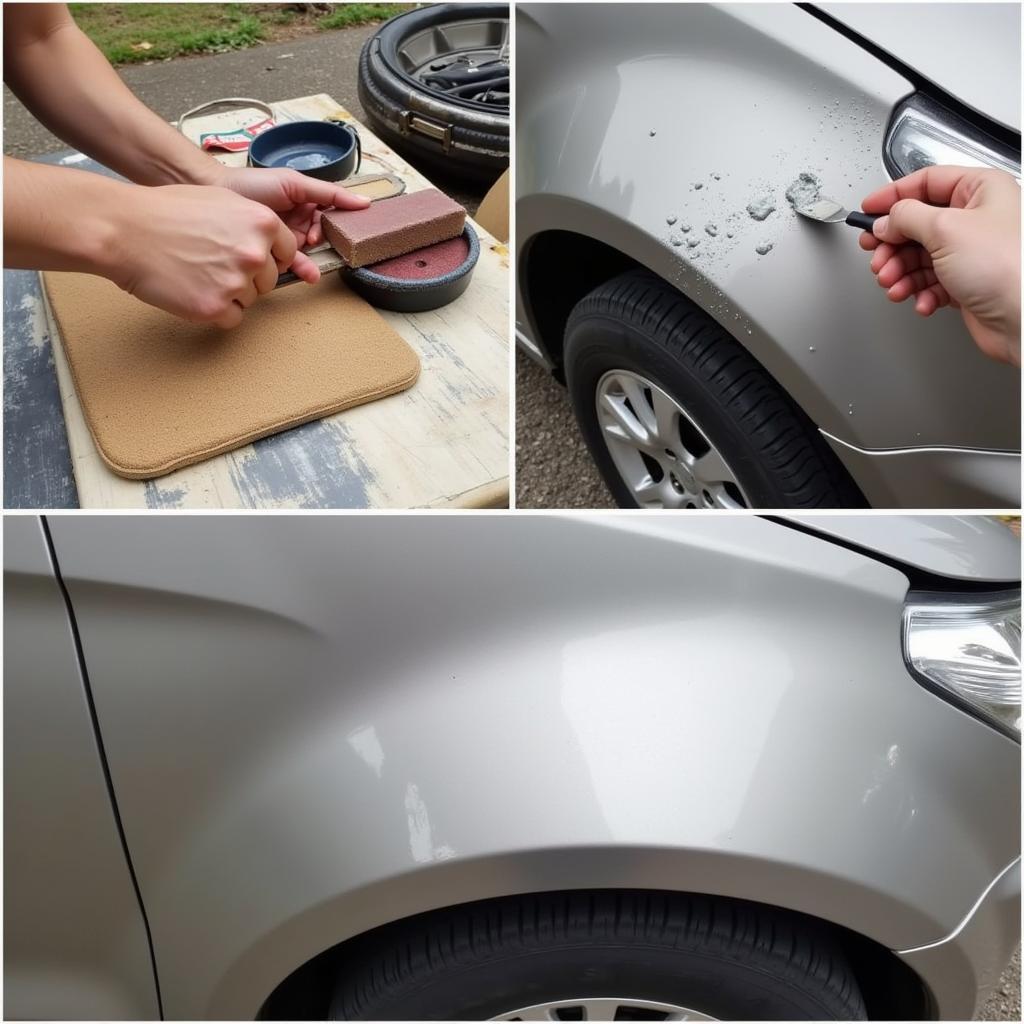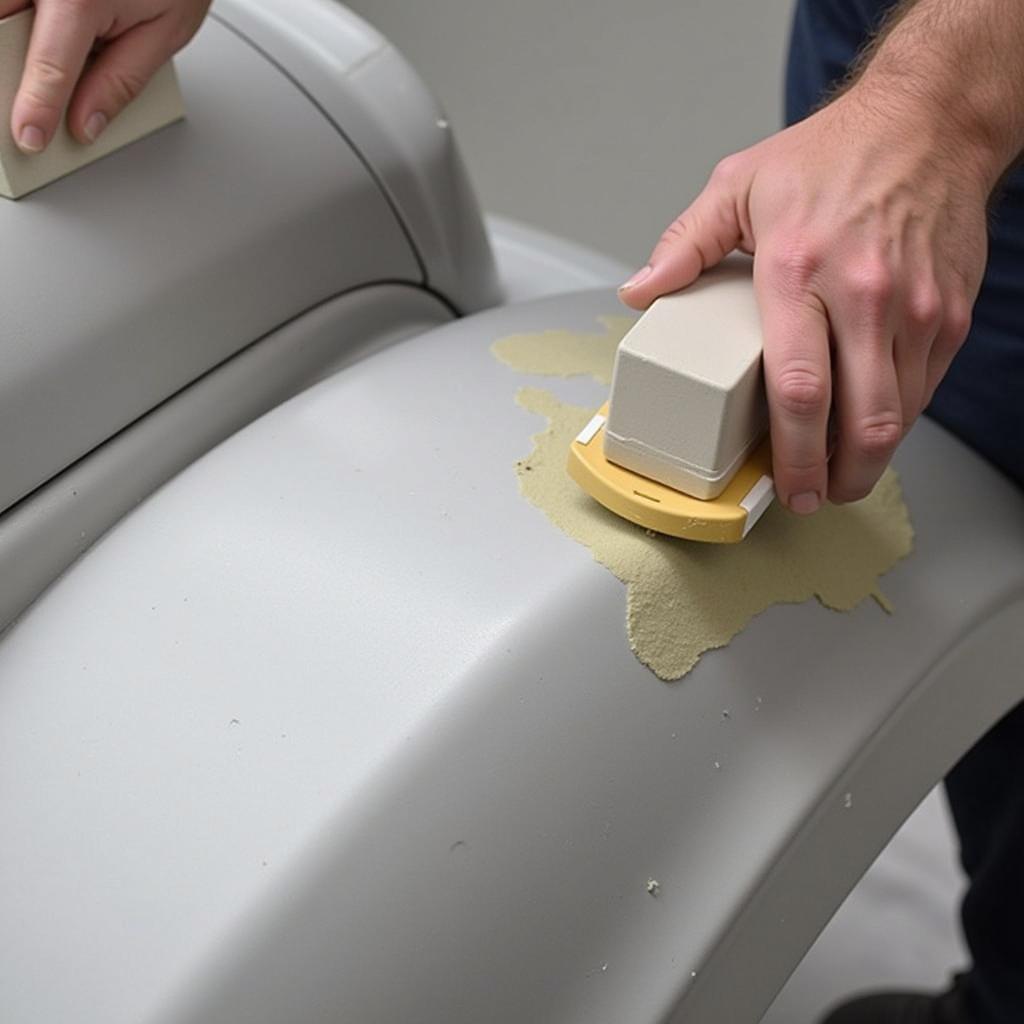Using bondo to fix a car fender is a common practice in auto body repair. It’s a cost-effective way to address dents, dings, and even rust, but it requires a careful approach to ensure a professional, long-lasting finish. This guide will walk you through the process, offering expert advice and practical tips. We’ll cover everything from preparing the surface to achieving that flawless final look.
Understanding When to Use Bondo on a Fender
Bondo, a brand name for body filler, is ideal for repairing minor to moderate damage on your car fender. It’s not a structural fix, so avoid using it for deep damage impacting the fender’s integrity. If the damage is extensive, consider how to fix a cracked metal body of a car. Bondo is best suited for surface imperfections like dents, dings, and small rust patches. It can fill these areas, creating a smooth surface ready for priming and painting.
 Applying Bondo to a Car Fender
Applying Bondo to a Car Fender
Preparing the Fender for Bondo Application
Proper preparation is crucial for successful bondo application. Start by cleaning the area thoroughly with soap and water, then degrease with a wax and grease remover. Next, sand the damaged area with coarse grit sandpaper to remove any loose paint or rust. If rust is present, use a rust converter to prevent it from spreading. This creates a clean, rough surface for the bondo to adhere to. Remember, a well-prepared surface is the foundation for a flawless repair.
Why is Cleaning and Sanding Important?
Cleaning and sanding are essential because they remove contaminants and create a rough surface, ensuring optimal bondo adhesion. Without proper preparation, the bondo may not bond correctly, leading to cracking and peeling later on.
Applying Bondo like a Pro
Mixing the bondo correctly is key. Follow the manufacturer’s instructions, ensuring the correct ratio of hardener to filler. Apply the bondo in thin, even coats using a plastic spreader. Overlapping each coat helps create a smooth, even surface. Don’t worry about getting it perfect on the first coat; you can always sand it down later. Patience is key here; allow each coat to dry completely before applying the next.
 Sanding Bondo on a Car Fender
Sanding Bondo on a Car Fender
How Much Bondo Should I Apply?
Apply thin coats, building up gradually. Applying too much bondo at once can lead to uneven drying and potential cracking.
Shaping and Sanding the Bondo
Once the bondo is completely dry, use coarse grit sandpaper to shape the repair area and blend it with the surrounding fender. Gradually move to finer grits to achieve a smooth, flawless surface. Feel the area with your hand to detect any imperfections. A good tip is to use a sanding block to maintain an even surface during sanding.
What Grit Sandpaper Should I Use?
Start with 80-grit and gradually move to finer grits like 180, 220, and even 320 for a perfectly smooth finish.
Priming and Painting the Repaired Fender
After sanding, apply a thin coat of automotive primer to the repaired area. This helps seal the bondo and provides a uniform base for the paint. Once the primer is dry, lightly sand it with fine-grit sandpaper to ensure a perfectly smooth surface. Then, apply your chosen paint, following the manufacturer’s instructions.
“A common mistake is rushing the priming and painting process. Patience and attention to detail are essential for a professional-looking repair,” says John Smith, a veteran auto body technician at Elite Auto Repair.
Conclusion
Fixing a car fender with bondo is a straightforward process when done correctly. Remember, preparation is key, and patience is your friend. By following these steps, you can achieve a professional-looking repair and restore your car fender to its former glory. If you have any questions or need assistance, don’t hesitate to contact us at AutoTipPro. You can reach us at +1 (641) 206-8880 or visit our office at 500 N St Mary’s St, San Antonio, TX 78205, United States.
“Remember, the key to a seamless bondo repair is proper surface preparation and meticulous sanding. Take your time, and don’t be afraid to ask for help if you need it,” adds Maria Garcia, Lead Technician at Garcia’s Auto Body Shop.
FAQ
- Can I use bondo on plastic fenders? Yes, there are specific types of bondo formulated for plastic repairs.
- How long does bondo take to dry? Drying time varies depending on the product and environmental conditions, typically 15-30 minutes.
- Can I apply bondo over rust? While bondo can temporarily cover rust, it’s crucial to treat the rust first to prevent it from spreading further.
- How thick can I apply bondo? Apply thin coats, building up gradually. Thick applications can lead to cracking.
- Do I need to prime before painting over bondo? Yes, priming is essential for proper paint adhesion and a smooth finish.
- Can I sand bondo with a power sander? Yes, but use caution and start with low speed and coarse grit to avoid removing too much material.
- How do I know if I’ve applied enough bondo? The bondo should slightly overfill the damaged area, allowing for sanding and shaping.




Leave a Reply